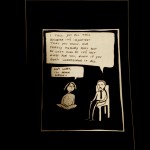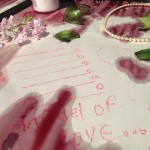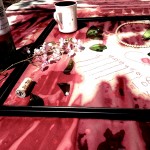Moriya’s Creative Experiment: Prologue
May 7th, 2014
Welcome to my creative experiment in understanding Muslim culture through the arts and literature. This is an attempt to find my unique voice in interpreting a religion that is integrated into many different aspects of my life and who is playing a major role in many of the issues I care about. As a third generation to Libyan immigrants who carried on with them much of the Islamic culture and Arab language into the Israeli melting pot of the 1950s, I engaged with my Arab ethnicity throughout my childhood only implicitly. In the rare occasions when the origin was mentioned, the stories were brief and technical. But as a child, growing up with the exotic image of Arabia inspired by Disney’s Aladdin and National Geographic footage I took pride in having such roots. Despite the fact that Islamic and Arab culture was all around me in my grandparents’ house I never had a chance to fully explore this part of my identity. Later in life, when I engaged in learning of Jewish history and studied the thousands of years of persecution, prejudice and hate Jews were facing in the diaspora I built the foundation for understating the notion of the “other” and the role of religious/ethnic entrepreneurs in feeding the circles of hate. To a certain degree, I developed sensitivity to the marginalization of specific groups based on their religious practices, appearances and cultures, but being fully free of prejudice is a privilege reserved for an elite minority, especially in the context of the daily reality in the State of Israel. Growing in a country that is surrounded by Arab nations, many of them hostile, and confronting the constant threat of war and terror, it was common to encounter prejudice, generalization, and demonization of Islam. In essence, the creative journey that follows this prologue is dealing with many of these interactions between my identities and world-views with Islam. It is an experiment that allowed me to reflect on my sources of knowledge with a critical lens, revisit views that have been accumulated throughout my life, and deconstruct them in a non-judgmental, safe environment.
The cultural studies approach that we applied to explore the practices, rituals and schools of thought of different Islamic communities of interpretation shattered the monolithic views of Islam to pieces. It was also incredibly useful in challenging some of my own paradigms that are a product of the context in which I was brought up. From the individual level of faith interpretation to the interpretations taking place in the international political sphere, this experiment is indeed a journey from the in out. In a way, the six creative blog posts that make up this portfolio tells my personal story and thought processes through several major themes and ideas we have covered this semester: communication, plurality in unity, authority and context, and controversy.
The first thread connecting many of the ideas I explore throughout this project has to do with the different methods and notions of communication and communion in the attempt to bridge the gap between the human and the divine. The tension between god being a far and distant transcendent being and yet very close and intimate, was the source of manifold traditions and practices purposed to resolve it. It was manifested in the idea of nature as a scripture, in the institution of prophets and the symbol of light, in mystical Sufi traditions and in the importance of visual, oral and written forms of the divine message. The idea of nature as a scripture and the depiction of natural forms in arabesque art inspired my blog entry “The Arabesque Fence.” This entry particularly related to my personal story, as it emphasized the notion that culture is blind to national/religious boundaries and the extent to which Islamic ideas are embedded and transmitted through culture. Exploring the spiritual dimensions of arabesque patterns and their depiction of natural forms highlighted the depth and orientation of the Islamic view of the natural world. The idea of communication is also manifested in the institution of prophets. Prophets seen as lamps who bring light in the form of revelations to earth to provide guidance to human kind, and are both reciprocals and transmitters of the divine message. Muhammad’s unique relations with god that is being told in the story of the miraj took on many different interpretations that were context dependent. To emphasize that dependency and provide my own interpretation to the role of Muhammad as an intercessor and perhaps a universal messenger, I wrote “The Convention of Lights.” The poem, exploring the role of the prophet in an inclusive monotheistic framework, relates to the theme of communication not only from the divine-human perspective but also from the human-human perspective. Perhaps the most surprising views on transcending the gap between the human and the divine can be found in Sufi mystical traditions. The role of poetry, rhythm, music and dance that are awakening the Sama and other forms of Zikr, is central in Sufi devotional practices. For me, exploring Islam through a Sufi lens demonstrated how little I know about the manifold practices of the religion. The Persian Ghazals and the controversial symbols and ideas they convey were most profound at confronting the view of Islam as a monolith. This view of communion with the divine seemed revolutionary to me and inspired the creation of one of my favorite blog entries “Bringing the Ghazal to Life”— I attempt to visually depict the Sufi mystical interpretation of bridging that gap through intoxication and other lyric symbols. The Ghazal is a powerful tool that can be recited orally or read, however my purpose for the visual installation was to capture the diversity in forms of expression. This also connects to another idea under the umbrella of communication—the idea that the divine message can take on many forms. In the entry “The Symphony of Faith” I express the importance of sound and calligraphy in Islamic traditions as forms of communication. “The Mystical Mug,” in addition to depicting the mystical power attributed to the written word of the Quran, is also demonstrating how wide is the spectrum of Islamic rituals and practices.
Another theme that is present throughout this project is the idea of plurality in unity. I found this idea very relatable because it provided a different framework to thinking about the similarities and differences between members of different monotheistic religions. The referencing of the Torah and the New Testament in the Quran, the acknowledgment of previous knowledge and prophets, the unity of message of submission to god and the heavenly prototype that is earthly manifested in different forms and through different scriptures, reshaped my understanding of the concept of “people of the book.” This aspect of plurality in unity is embodied in the entry “The Convention of Lights.” “Bringing the Ghazal to Life” touches on the idea of plurality in unity indirectly by alluding to the primordial state of being in which all of creation is in union with god prior to the separation. The other representation of plurality in unity appears within the family of Islamic traditions which share the same basic “ingredients,” as professor Asani referred to them: the oneness of god, the Quran, and the prophet Muhammad. While the core ideas are similar, the range of interpretations is incredibly wide and responsible for very different practices, rituals and shaping of world views. “A Mystical Mug,” for example, is inspired by a unique interpretation of the divine word as a healing instrument. “Memory. Defiance.” is related to a different form of interpretation of Islam as a political ideology and the notion of the perfect state as the state of the prophet.
Two issues that were central to understanding of some of the entries and the overall message were questions of authority and context. The monolithic view of Islam is often grounded in the notion that Islam is an entity governed by a meta-authority dictating a specific set of values and world perspective, while authority is actually dispersed and very much controversial. The lack of attention to context and the influence of context on the multiplicity of manifestations of Islam contribute to the perseverance of monolithic perceptions. “Memory. Defiance.” Is embodying the double-edged tragedy of politicizing Islam to support a certain political ideology and monopolization of Islamic interpretation by the state; the tragedy is shared by Muslims who poses interpretations of Islam that are different from those held by the state and Muslims in general, who have to bear the consequences of the impact on broad perception of Islam influenced by the use of Islam to support political ideology, such as in the case of the Islamic republic of Iran. The idea of memory that is emphasized in this blog entry stresses that the context in which people live their lives, being political, economic, social etc. deeply impacts their religious identity and shapes their own interpretation of religion. Perhaps the greatest natural experiment of how context influences people’s perceptions of their own religious practices as well as “outsiders” view on Islam were the events on 9/11, which provide the setting for the story of Changez in the Reluctant Fundamentalist. In the entry “Back to the Fundamentals” I attempted to express the double-edged tragedy that is a product of the context of the terror attack on the world trade center. The issue of authority also comes into play in “Bringing the Ghazal to Life,” as the state of intoxication is reversed from halal into an act of communion in Sufi interpretation, while in many Muslim countries such as Saudi Arabia and Bangladesh alcohol is completely banned. The authority on interpretation lies with those in power.
Finally, the underlying theme of the issues this project engages and perhaps the most profound in countering the notion of the monolithic Islam was controversy. In “The Symphony of Faith” controversy is present around the debate about the role of music and calligraphy in Islam. While some reform movements tagged music as adultery and corruption, for Sufis it is an integral part of awakening primordial memories in ritual practices. Certain interpretations accept the art of recitation of the Quran as music and others don’t. As to calligraphy, the calligraphic representation of Muhammad, for example, using his attributes is also controversial among Muslims. In “The Convention of Lights” controversy is embodied in the idea of the prophet as an intercessor that has been the source of great faction in the Sunni Shi’a division. “Bringing the Ghazal to Life,” as mentioned before, deals with the broad controversy around the idea of intoxication as an act of communion and love between humans as a stepping-stone to the divine love. The depth and breadth of controversies within the world of Islamic faith traditions, that are present throughout this creative experiment, are a testament to the folly of generalization.
I hope this work will go beyond serving my own intellectual development and understanding of people, opinions and events. I hope that through my lens, the lens of an Israeli Jew with some roots tracking back to Arab culture, the clash of ignorance, misunderstanding and stereotyping will be replaced by coexistence, tolerance, and hope.
BACK TO THE FUNDAMENTALS
May 2nd, 2014
Week 13’s reading The Reluctant Fundamentalist inspired an idea of an alternative 9/11 memorial. Reading about Changez’s identity struggles as a young Pakistani man in the post 9/11 United Sates, made me consider aspects of the human tragedy that usually don’t have enough space in the public discourse in America. I thought of the victims of the terror attack on the world trade center, on the thousands of lives that were lost and the millions of lives that were brutally scarred forever; but maybe for the first time, I also thought, specifically, of the Changezs that lost their lives in the attack. I thought of the Pakistanis, the Afghans, and the Iranians who were proudly trading Fed bonds in these towers the day the planes crashed; I thought of devout Muslims or those who may have considered their Islam no more than their cultural identity, who lost the people they loved and cherished; I thought of all those people who were not only victims of the terror attack but that were, to some extent, forced to bear the blame in the aftermath of the events—those who were cynically victimized twice, by each of the worlds they were attempting to bridge. It reminded me of the discussion we had in class about the role of the veil in securing identity at a time when identity was under attack; the idea of the veil as a symbol of culture that was made into a symbol of Islam. Sometimes things don’t fit into molds we already have created in our minds, but for lack of alternative we force them into those molds anyway, and sometimes, unintentionally, we end up deepening the tragedy rather than healing. This alternative monument would contain a humble quote, one of my favorites quote in the novel. This quote should serve as a reminder that the enemy who brought this tragedy upon us is no monolith and that by demonizing people based on their religious beliefs, cultures or traditions, we turn them into “reluctant fundamentalists;” we, ourselves, feed the circle of hate and divergence. A little space for the other dimension of the tragedy could have made all the difference between perpetuating our noble values and aspiring to be even better.
Memory. Defiance.
May 2nd, 2014
Week 12’s Persepolis simply blew my mind. There was so much in this simple, humoristic, yet remarkably deep and critical graphic novel that made me want to recreate it on the four walls of my dorm room. To channel this energy to a more feasible alternative I chose to recreate one of the blocks I loved most in the story, and that I found most relatable. This block deals with the powerful idea of memory, and in it, Marji is asked to remember and never forget the history of her family at a time when many of her identities are being attacked, in the context of the Islamic revolution. It reminded me of a famous quote by Aeschylus: “in war, the first casualty is the truth” and indeed, in the midst of the many wars that are taking place simultaneously in the story on various level (international, national, personal, religious, social-economic, gender-related etc.), the emphasis is not necessarily on the physical lives that are lost but on truths, identities and narratives that are challenged. In class we discussed the history of Iran, the rise of the islamist movements and the characteristic of Islamic ideologies. The story of Persepolis brought to life many of these topics and depicted the role of memory as defiance within a complex political context. Just as many citizens of post-colonial countries were forced to forfeit their identities, cultures, languages and religions and conform to the dictates of the nation state and the ideologies that were employed to solidify it, so did Marji and her family. Consequently, in the case of Iran, that ideology happened to be Islamic and the implications of the appropriation and monopolization of Islam by State brought on much antagonism and demonization of the religion on both national and international levels.
Bringing the Ghazal to life
May 2nd, 2014
Inspired by week 9’s reading The Green Sea of Heaven by Elizabeth Gray, I decided to try and illustrate the Persian love lyric in a still installation of some of the motifs we encountered throughout this unit. It was an attempt to bring the Ghazal to life.
In class and in section we discussed at length some of the issues mentioned in Gray’s piece, such as human love as a stepping stone to the divine love, the many classic motifs that are found in the Ghazal, the open symbolism and the gender ambiguity, and capturing the experience of ecstasy in a poetic form. We talked about the mystics’ dilemma in regards to expressing things that are beyond rationality, language or analysis and of poetry being an effective device. We also discussed the key and controversial idea of intoxication in Islam and how Sufi tradition reverses the role of intoxication from an act of halal to the complete opposite—a state of experiencing the divine love and practicing Islam in the most truthful sense. In addition, we talked about the contrast between yearning as a source of pleasure as well as suffering, as Gray points out: “the true lover understands the ecstasy and the pain of loving.” This installation is attempting to capture all of that at once. It is attempting to illustrate chaotic ecstasy that is, literally, framed to accommodate some sense of order and rationality. It is trying to capture the controversy by displaying chaos that may be erotic and pleasurable but may also be violent and dangerous. It is attempting to capture pleasure and suffering at the same time.















